Follicular Unit Extraction (FUE), also known as Follicular Unit Excision and Follicular Unit Transplant* (FUT), are the two most common methods of hair transplantation surgery. Therefore, knowing the differences between the two methods is an important research point for prospective consumers. So what are the differences between FUE and FUT?
FUE and FUT: The Main Difference
FUT and FUE refer to harvesting hair follicles from the donor area for implantation into an area of baldness or hair loss called the recipient. The main difference between the two approaches lies in the specific technique and method used to harvest grafts from the donor area.
In FUE, grafts are individually harvested directly from the donor area. Consequently, FUE wounds are tiny enough to heal with little cosmetic footprint. For this reason, hair can be harvested using FUE from non-head regions, including the face, and other body parts, chest, abdomen, back, shoulders, arms, legs, etc. In FUT, however, a hair-bearing strip of the scalp is surgically excised from the donor area. The hair follicles in the strip of the flesh are then individually extracted under magnification. FUT would necessarily result in a linear wound that would cause a linear scar in its wake. For this reason, FUT donor areas are confined to the head, where the hair must be grown long enough to hide the scar.
Compared to FUT, FUE is the most popular hair transplantation method. This is driven mainly by higher patient demand due to several advantages of FUE, not least of which is avoiding the linear strip scar created by FUT (see Table 1).
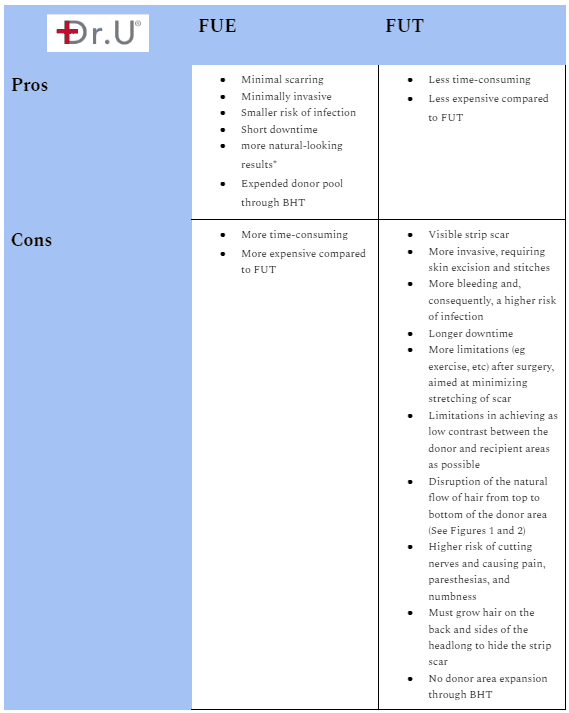
In-Depth Comparison: Medical Considerations (FUE VS FUT)
Dot Wounds and Dot Scars Vs. Linear Wounds and Linear Scars
As mentioned above, in FUT, the surgeon takes a sliver of skin from the donor area to implant pieces in the recipient area. Consequently, the donor area will need stitches to close the wound left behind due to the excision. In contrast, In FUE, your doctor will make small holes in the donor area with an FUE punch and then harvest hair grafts from the recipient area. A graft comprises the hair follicle and a small amount of skin directly surrounding the follicle.
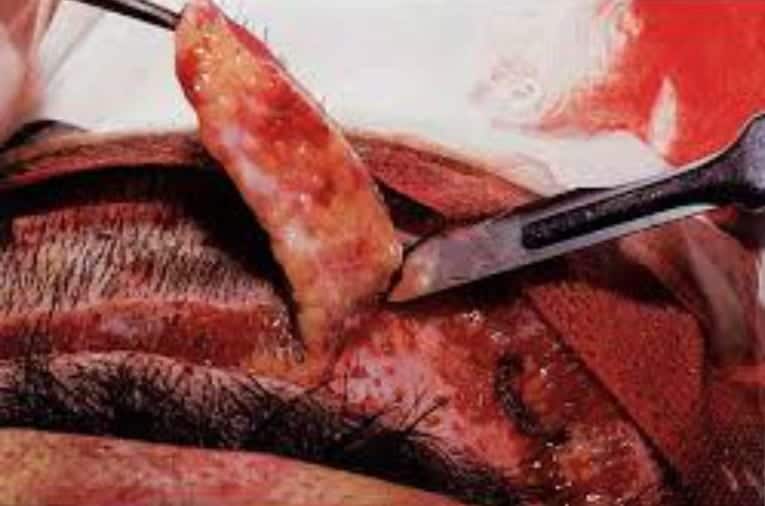
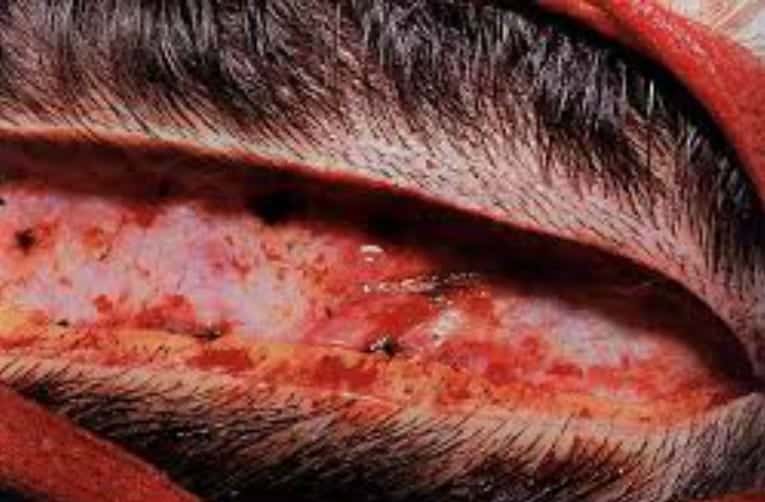
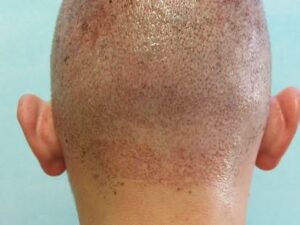
Since neither the donor nor recipient area has to undergo significant wounding in FUE, there’s no need for stitches in either area. Smaller wound sizes and no stitches also entail minimal scarring, unlike the scarring in FUT. Coming out of a FUT surgery with a scar is pretty much inevitable. Because of how common it is, it even appears in the alternate name for a FUT surgery – strip scar surgery and follicular unit strip surgery (FUSS)
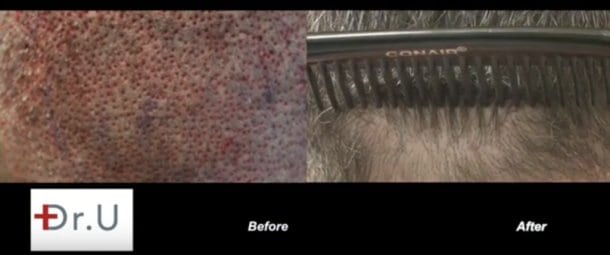
FUE Vs. FUT: The Myth Of Undetectable FUT Scar
This brings us to another disadvantage of FUT. Patients often seek hair transplantation surgery to wear their hair short instead of growing it out and maneuvering it in a fashion that covers the balder spots (The so-called “comb-over).” Unfortunately, many FUT surgery patients realize too late that they will still need to grow out their hair to hide the post-surgery strip scar, defeating the surgery’s point.
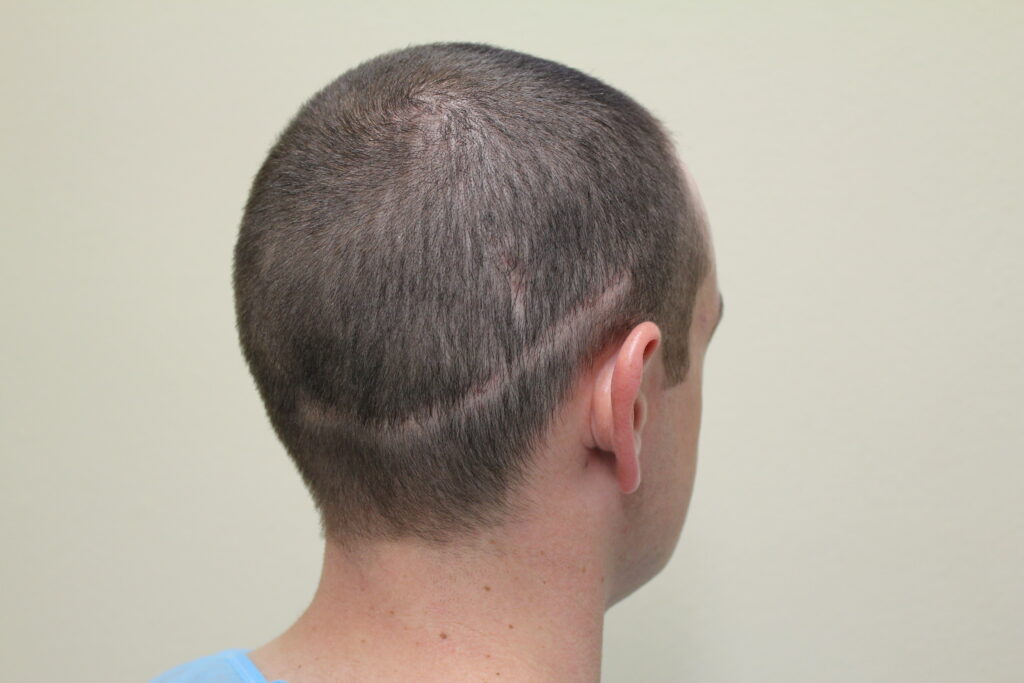
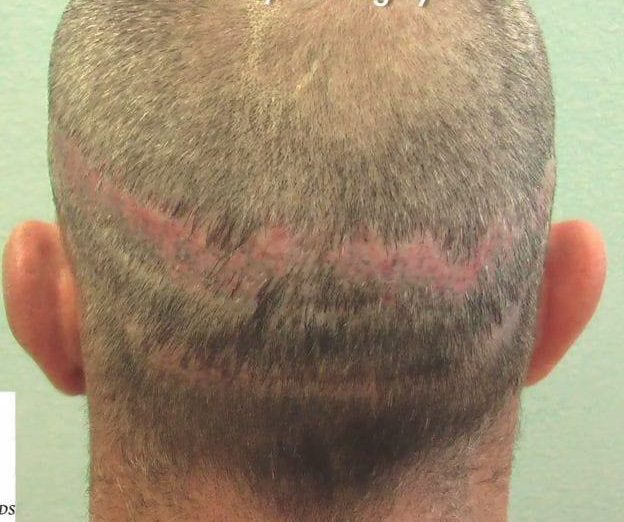
FUT Vs. FUE: Wound Complication Risks
Both FUE and FUT carry a minimal chance of infection. However, because of the contiguous linear wounds and stitching required in FUT, there are more chances of wound complications, including wound infection, wound dehiscence (aka wound breakdown), and poorer scarring.
FUT Vs. FUE: Downtime Considerations
Another advantage of FUE over FUT, which stems from the fact that FUE is minimally invasive, is the difference in downtime. With both FUT and FUE, it takes about 3-4 days for the grafts to settle into the transplanted area. Thus, in the first 3-4 days after hair transplant surgery, you should not engage in any activity that can physically dislodge the grafts.
However, the post-op restrictions imposed on FUT patients are much more exacting. This is because the donor wound size is much bigger, and when stretched, it may expand. The stitches may also come out when strained too early after the surgery. Because of this, there are stricter restrictions and more extended downtime. In addition, these restrictions stretch into the entire 6-month period post-surgery because the final size of a strip surgery scar may take six months to form. Therefore, all factors that can mitigate scar stretching must be minimized during that period.
FUE Vs. FUT: Nerve Damage Risks Considerations
The invasive aspect of FUT also poses a higher risk of cutting nerves and causing pain, paresthesias, and numbness. There are numerous nerves on the back of the head, and excising a strip of the scalp is an easy way to damage those nerves.
FUE VS FUT Aesthetic Considerations
First, hair has a natural flow – from top to down. A strip hair harvesting surgery disturbs that flow because after the strip of flesh is cut, closing the resulting wound misaligns the pre-existing line of hair pattern between the area above the wound and the area below it. To illustrate this better, imagine an upside-down triangle with lines connecting its base to the peak. If you cut a rectangular shape in the middle of the triangle and then bring the two remaining pieces to close, the lines going from the base to the peak aren’t going to align as seamlessly (Figure 1).
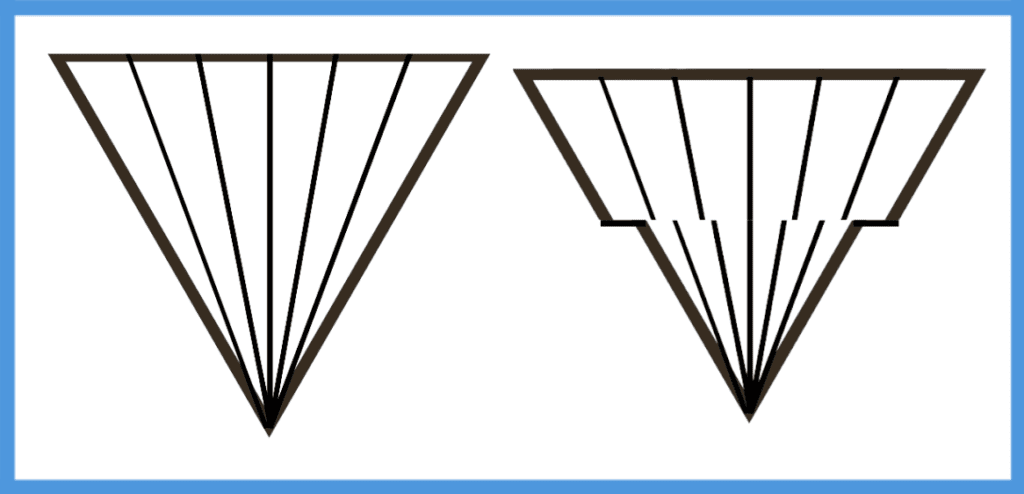
When the flow is disturbed, it becomes apparent to onlookers that the person has undergone a hair transplantation surgery, as the results are not natural-looking. Additionally, the hairs near the scar would get distorted because of the disruption of the surrounding tissue from the scarring process. As a result, those hairs grow in random and chaotic directions, creating a weird look (Figure 2).
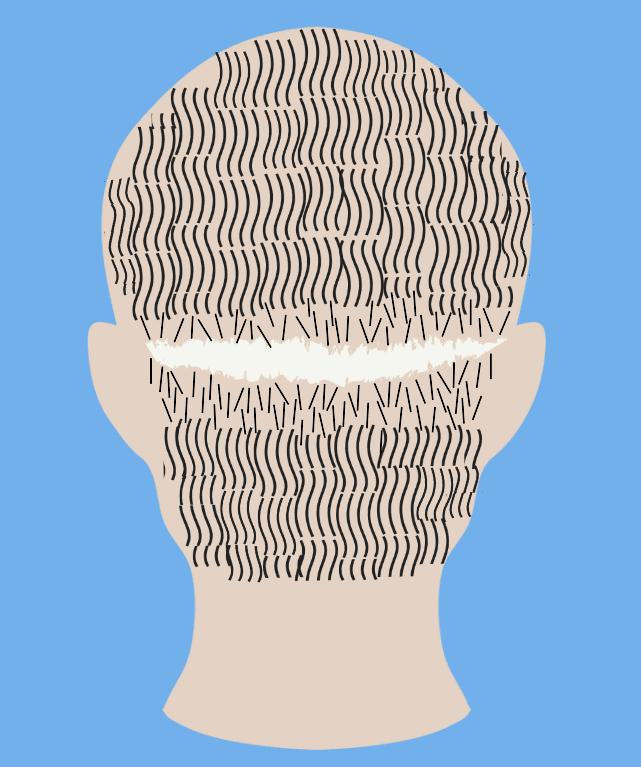
Hair Loss in FUT Scar Vicinity
It’s also worth mentioning that many patients experience hair loss at and around the donor site after a FUT surgery. Sometimes it’s shock loss and can be temporary. Other times, it’s due to compromised blood supply in the area, which becomes a permanent issue. In that case, the way to grow hair in the area again would be through FUE. So essentially, FUT becomes an extra unnecessary step in the process.
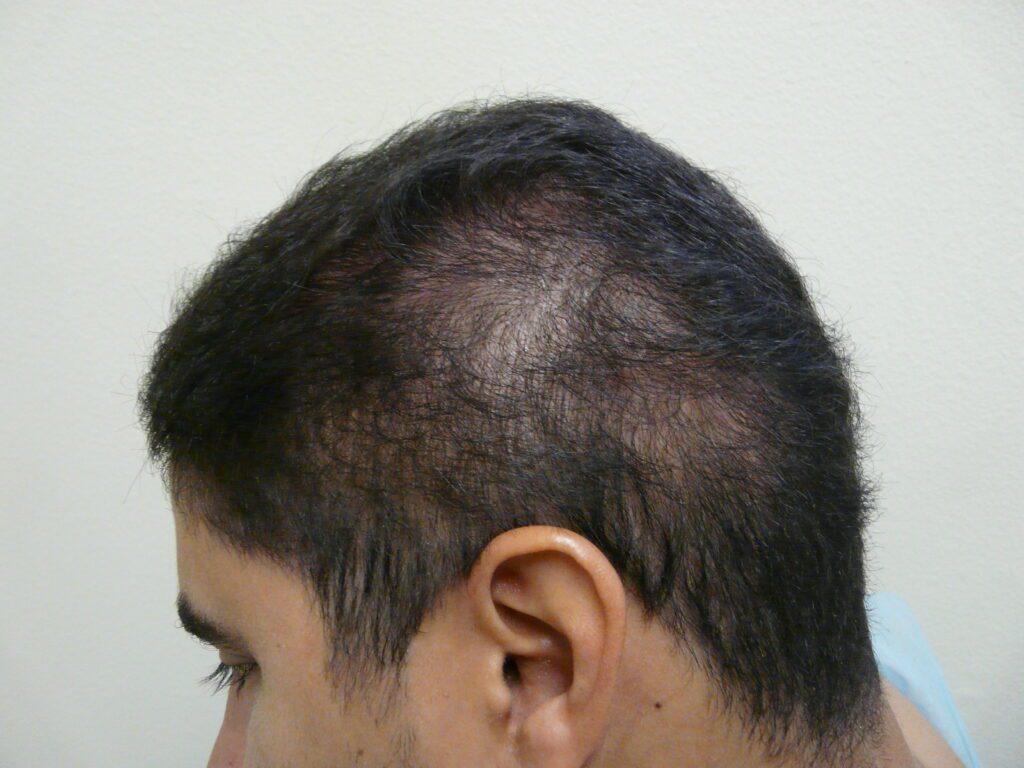
FUE Vs. FUT: Who Wins the Game of Contrasts?
The appearance of baldness is at least as much about contrast as it is about numbers. Having a lot of thick, dense hair in one part of your head and less hair in another will create a contrast, making it apparent that you’re balding. On the other hand, having just enough hair for decent coverage evenly distributed all over your head will make you appear less bald.
What are the ramifications of contrast in the FUE vs. FUT discussion?
In FUT, all the donor hairs come from a narrow linear corridor of the back and sides of the head. As a result, the density of the hair in the non-thinning area remains relatively the same, save the strip that’s being excised. To illustrate further, if 100 hair follicles are included in the strip theoretically, 100 hairs add to the recipient area’s density.
In contrast, the donor area density stays unchanged- you now have a scar.
Linear Scar Covering Effect
As previously mentioned, post-FUT, patients often need to grow out their hair to hide the linear scar. Growing out the hair emphasizes the contrast between the donor and balding areas, and as discussed, the contrast makes you look balder. Ultimately, FUT surgery creates a cycle of needing to grow out hair to cover the scar, resulting in a higher contrast with balding areas for a balder look that begs for another hair transplant to address. Still, another FUT creates more linear scarring, which must be hidden, necessitating the need to grow out the hair even more, and the cycle continues. Therefore, getting an FUE hair transplant surgery from the start eliminates or minimizes the contrast between the donor and the balding areas WITHOUT causing a prominent scar.
FUE Reduces Contrast In Two ways
Back to contrast and baldness. As already stated, all donor follicles in FUT come from a narrow strip of the scalp; as a result, the hair density remains the same in the rest of the donor area.
Consider the scenario where the same patient gets an FUE hair transplant instead. For instance, if the FUE doctor extracts 100 grafts, with one follicle per graft. Because the donor area is not confined to a strip, those 100 grafts are taken from a larger donor area that your doctor deemed safe. As a result, the hair density in the donor area is reduced, lowering the contrast between the donor and recipient areas.
Donor Area Limitations in FUT
This brings us to another significant difference between FUE and FUT. Again, in FUT, the donor area is confined to a small strip of the scalp. Aside from the fact that FUE allows graft harvesting from a larger safe zone if your FUE doctor is adequately equipped, they can derive grafts from non-head areas of your body, and there are several reasons why a patient may want this. Extreme baldness is the most apparent reason for opting for a body hair transplant (BHT) surgery. Someone with Norwood 6 or 7 may quickly be deemed unfit for a hair transplant surgery, as the donor area is often not large enough to provide sufficient coverage to the recipient area.
Furthermore, in FUT, the surgeon’s choice of hair types (singles, doubles, finer, softer hairs, etc.) is limited to whatever type of hair is available in the narrow strip of flesh they harvested. Since FUE allows the surgeon to harvest from the donor area, they can cherry-pick hair that best meets their recipient area objective. For instance, they can derive softer hairs from the nape and ear areas to construct more natural, softer temple points of thinner/finer hairs.
Body Hair Transplant is the Answer
With BHT, how much hair you have left on your head has minimal bearing in qualifying you for hair transplant surgery. If the doctor has experience with body hair harvesting and an advanced FUE machine, such as the UGraft Zeus, they can use your beard, neck, chest, arm, leg hair, and more. So in that sense alone, BHT is already a game-changer in hair transplantation. But the advantages of BHT don’t stop at the level of necessity alone.
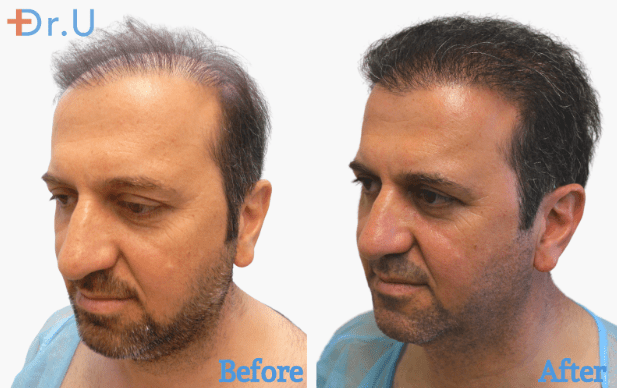
The hair in the area on the back of the head, traditionally esteemed as the safe donor zone, is generally thicker and coarser than the hair that makes up the hairline. So, for instance, implanting coarser hair in the receding hairline will result in an artificial appearance, as the transplants won’t blend in with the rest of the hair.
Consider the texture of different body hair now. Nape hair, for instance, is much softer in texture than the hair on the occipital area of the scalp, where the FUT strip is typically derived from. So are arm and leg hair. Grafting the hairline with hair taken from any of those non-head areas would ensure a smoother blending and result in a final look that is typically less detectable.
FUT Vs. FUE: Cost Considerations
If your hair transplant surgery budget is low, FUE may not be accessible. Generally, FUE costs more than FUT surgery. This is because, in FUE, grafts are extracted individually. This means the follicular unit extraction procedure is more time-consuming, requiring more exertion of skill sets and technology exertion. Add to that the fact that FUE results are also superior for the above reasons, and it makes sense how the two transplant surgeries would be in different price ranges.
When looking for a hair transplant clinic and surgery, you should ask yourself your goals and priorities. Remember that you will live with the surgery results for the rest of your life (unless you get a repair surgery, if necessary). Therefore, invest in a clinic that will deliver what they promise so that you do it once and well.
Frequently Asked Questions
Is an FUE hair transplant a permanent solution to hair loss?
Successfully transplanted hair should not fall out, so it’s a permanent solution on the transplantation site. However, with time, your hair loss may progress, which means there will be a gap between your natural hairline and the transplants. In that case, you may want a second FUE procedure to close the gap.
Would I have to shave my head for an FUE hair transplant surgery?
Traditionally, FUE surgeons require you to shave your head before the procedure. However, if you undergo surgery by a practitioner who uses an advanced FUE machine, such as the UGraft Zeus, you won’t be required to shave your head. This may not apply to every FUE machine marketed as advanced, but the UGraft Zeus is fully equipped to harvest grafts on patients with long unshaven hair.
References
- Ferguson S. Hair follicle: Function, anatomy, and Conditions. Healthline. https://www.healthline.com/health/hair-follicle#anatomy. Published February 13, 2019. Accessed October 18, 2022.
- Hair loss. Mayo Clinic. https://www.mayoclinic.org/diseases-conditions/hair-loss/symptoms-causes/syc-20372926. Published March 26, 2022. Accessed October 18, 2022.
- Umar S. Body hair transplant by follicular unit extraction: My experience with 122 patients. Aesthetic surgery journal. https://pubmed.ncbi.nlm.nih.gov/27241361/. Accessed October 18, 2022.
- Umar S, Lohlun B, Ogozuglu T, Carter MJ. A novel follicular unit excision device for all-purpose hair graft harvesting. Clinical, cosmetic, and investigational dermatology. https://www.ncbi.nlm.nih.gov/pmc/articles/PMC8605797/. Published November 16, 2021. Accessed October 18, 2022.
- Umar S. Use of nape and peri-auricular hair by follicular unit extraction to create soft hairlines and temples: my experience with 128 patients. Aesthet Surg J. 2015 Nov;35(8):903-9.
*Although the term FUT is almost exclusively used to refer to strip transplantation surgery, it relates to Follicular Unit Extraction (FUE) and Follicular Unit Strip Surgery (FUSS). Therefore, the strip surgery can be called FUSS, FUT, and FUHT (Follicular Unit Hair Transplant). The FUE surgery can also be referred to as FUT and FUHT, along with the most common abbreviation – FUE. In this article, FUT refers only to strip surgery.
